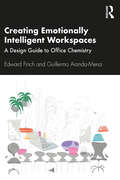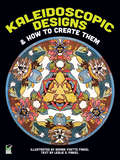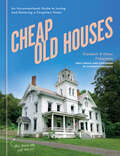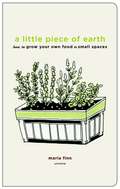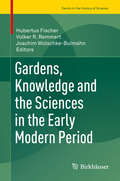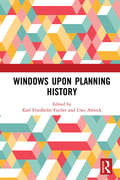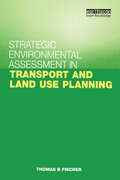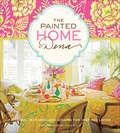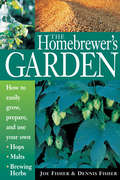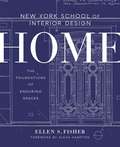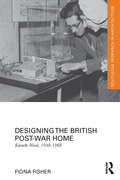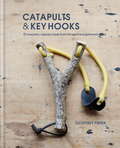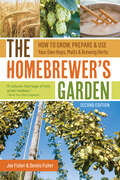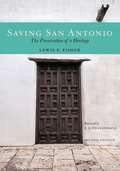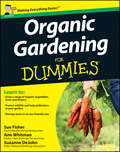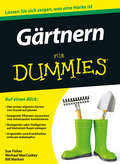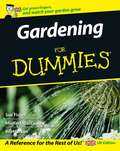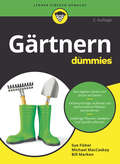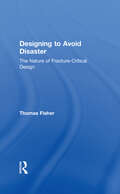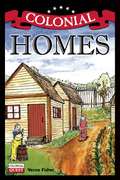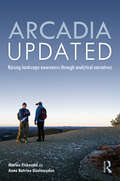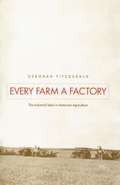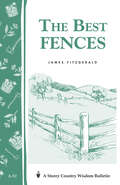- Table View
- List View
Creating Emotionally Intelligent Workspaces: A Design Guide to Office Chemistry
by Edward Finch Guillermo Aranda-MenaEmotions in the workplace have until recently been seen simply as a distraction. We often think of work as rational, logical and non-emotional. But organisations are waking up to the key role of emotions and affect at work. Emotions influence how we make decisions, how we relate with one another and how we make sense of our surroundings. Whilst organisations are slowly embracing the pivotal role of emotions, designers and managers of workplaces have been struggling to keep up. New insights from hard sciences such as neuropsychology are presenting a radically different interpretation of emotions. Yet workplace designers and facilities managers still rely on measuring non-specific states such as satisfaction and stress. In this book we attempt to capture modern-day interpretations of emotion, looking at emotion in terms of transactions and processes rather than simple cause and effect. We entertain the idea of an ‘emotionally intelligent building’ as an alternative to the much-hyped intelligent building. The assertion is that we should create environments that are emotionally intelligent. Rather than focusing on the aptitudes or shortcomings of individuals at work, we should place closer attention on the office environment. It’s not that we are emotionally disabled – it’s the environment that disables us! The ability of you and me to interpret, control and express emotions may not simply be a result of our own make-up. A radically different outlook considers how our workspace and workplace debilitates or enables our emotional understanding. In the modern workplace there are many innovations that can undermine our emotional intelligence, such poorly implemented hot-desking or lean environments. Contrariwise there are key innovations such as Activity Based Working (ABW) that have the potential to enhance our emotional state. Through a series of unique case studies from around the world, we investigate key concepts that can be used by designers and facilities managers alike. No longer should designers be asked to incorporate emotional elements as intangible un-costed ‘add-ons’. This book provides a shot in the arm for workplace design professionals, pointing to a new way of thinking based on the emotional intelligence of the workplace.
The Home Security Handbook: Expert Advice for Keeping Safe at Home (And Away)
by Lynne Finch Mike SeeklanderDo you know what to do if you think someone is in your house? What if an unmarked car is trying to pull you over on a dark and lonely? Author Lynne Finch takes a comprehensive look at ways to improve your family's immediate safety and methods for protecting them in the future. Finch covers a wide range of topics from temporary ways renters can make their home secure, to more permanent changes an owner can make. As well as travel tips for domestic and international travel, with suggestions as simple as how to use your luggage tags to not only make your bag distinct, but to be more security conscious.Through interviews with Law Enforcement officers, Finch provides advice on how to handle various social interactions that keeps you from becoming a victim. These safety suggestions are helpful to readers of all ages, and a must-read for those just going off to college. Learn how to keep your drink safe at a bar or club, and prevent your friend from becoming a target. As well as what to do if someone is following you home at night.Home Security Handbook is a well researched, thoughtful look at a serious subject that affects everyone live's. Written in an approachable, conversational style, Finch provides informative tips that help prepare readers to deal with the most common safety concerns.
Kaleidoscopic Designs and How to Create Them
by Norma Y. FinkelKaleidoscopic designs are thrilling in their profusion of color and repeating patterns, but they look so complex that creating one would seem to be virtually impossible. Norma and Leslie Finkel have done the impossible. They have discovered a simple way to create unlimited numbers of kaleidoscopic designs (in 4, 6, or 8 segments). Best of all, you don't have to be an artist to do it, since any printed illustration can be used as the basis of a design. All you need are tracing paper, carbon paper, and a few other inexpensive items. The Finkels give step-by-step instructions for creating handsome circular designs; they also offer 37 plates showing completed designs based on such themes as nature, animals, sports, and abstract arrangements. Four of these designs are shown in color on the covers.
Cheap Old Houses: An Unconventional Guide to Loving and Restoring a Forgotten Home
by Elizabeth Finkelstein Ethan FinkelsteinFrom the founders of the HGTV show and Instagram Cheap Old Houses comes a stunning collection of beautiful, affordable homes and inspiration for buying and restoring an historic house.Welcome to the magical world of Cheap Old Houses, where the new American dream comes with zero mortgage and an affordable lifestyle fit for a storybook. Ethan and Elizabeth Finkelstein have scoured the country to find homes in desperate need of saving—including a $45,000 Victorian in Mississippi, a $25,000 mansion in Indiana, an $82,000 recreational camp in Maine, and more. Cheap Old Houses features the stories of how these homes were acquired and lovingly restored.Within these pages, you&’ll discover sprawling Victorian mansions, Italianate-style farmhouses, off-the-beaten-path cabins, and even old churches turned into residences. You&’ll meet a couple who camped out on their back porch while they made their 6,000-square foot manor livable, and homeowners who found a free bungalow and moved it seventy miles to their property. Additionally, Elizabeth, a historical preservationist, gives information on the details to preserve in historic houses, from pocket doors that might be hiding in the walls to badly cracked plaster walls that are worth repairing and butler&’s pantries that are once again more desirable for storing dishes and small appliances.With hundreds of beautiful photographs capturing these homes in all their glory, you&’ll be inspired to find &“the one&”—a fixer upper to rescue that will rescue you right back.
A Little Piece of Earth: How to Grow Your Own Food in Small Spaces
by Maria FinnA hip, eco-friendly guide with fun and easy projects for all levels. Eating locally has so many benefits--for the planet, for your health, and for your taste buds--and you can't get much more local than your very own backyard. But is planting a garden too big a commitment? Then this book is for you. A Little Piece of Earth is all about starting small, with more than fifty self-contained, doable projects. Whether you have a yard, a terrace, a rooftop, or just a windowsill, there are plenty of ideas and inspirations to choose from. Harvest your own precious vanilla pods from a pot indoors. Grow savory shiitakes on a small log in your kitchen. Build a miniature vineyard trellis on your deck or build a raised bed on your patio. Recipes for using your homegrown bounty are sprinkled throughout. Charming illustrations guide you through step-by-step, and there's a complete resources section. This is about making dirt work for you, taking some control over your food supply, and, most important, enriching your life with the quiet, simple pleasures of produce raised organically with your own hands.
Gardens, Knowledge and the Sciences in the Early Modern Period
by Hubertus Fischer Volker R. Remmert Joachim Wolschke-BulmahnThis volume of proceedings primarily focuses on the outstanding contributions made by botany and the mathematical sciences to the genesis and development of early modern garden art and garden culture. The many facets of mathematical sciences and botany point to the increasingly "scientific" approach that was being adopted in garden art and garden culture in the early modern period. This development unfolds in interaction with philosophical, religious, political and social processes and beliefs. This volume strikingly shows that such processes are able to make use of the knowledge of nature manifested in gardens for various purposes. The conference that inspired this volume was jointly organized by the Leibniz Universität Hannover's Centre of Garden Art and Landscape Architecture (CGL) and the Bergische Universität Wuppertal's Interdisciplinary Centre for Science and Technology Studies (IZWT).
Windows Upon Planning History
by Karl Friedhelm Fischer Uwe AltrockWindows Upon Planning History delves into a wide range of perspectives on urbanism from Europe, Australia and the USA to investigate the effects of changing perceptions and different ways of seeing cities and urban regions. Fischer, Altrock and a team of 13 distinguished authors examine how and why the ideologies and the processes of city making changed in modern and post-modern times. Illustrated with over 45 images, the themes addressed in the book range from the changing outlook on Berlin’s historic apartment districts and their demolition, salvation and gentrification to how planning was deployed to support dictatorship; from the shattering of myths like democracies totally departing from preceding dictatorships to the model of the post-war modern city and its fate towards the end of the twentieth century. The volume combines case studies of cities on three continents with reflections on the historiography and the state of planning history. With a foreword by Stephen V. Ward, this book will appeal to a wide readership interested in the histories of planning, architecture and cities.
Strategic Environmental Assessment in Transport and Land Use Planning
by Thomas B. FischerAssessing the full scale of environmental impacts is essential for effective planning of transport and land use. This is an analysis of transport and land-use planning using strategic environmental assessment (SEA). It establishes the effectiveness of SEA through comparative studies of practice in three countries: Britain, the Netherlands and Germany. The author shows that use of SEA is widespread but far from systematic. He demonstrates the advantages of adopting a systematic application of a comprehensive form of SEA derived from all the major current approaches. Only once this approach is fully understood and systematically applied will all the full benefits be achieved and environmental impacts be minimalized.
The Painted Home by Dena: Patterns, Textures, and Colors for Inspired Living
by Dena Fishbein John EllisA renowned designer shares surprising ways to add color, texture, and creativity to your home. In this beautifully illustrated book, the woman behind internationally acclaimed merchandise company Dena Designs shows how her hand-painted style combines vintage and traditional elements with a modern twist. Pick up a paintbrush and take a walk through the author’s own home, room by room, as she discusses her inspirations and demonstrates her methods for encouraging creativity. The Painted Home features simple DIY projects, useful design tips, and personal stories from one of the most successful entrepreneurs in the textile and design business.
The Homebrewer's Garden: How to Easily Grow, Prepare, and Use Your Own Hops, Malts, Brewing Herbs
by Dennis Fisher Joe FisherGrow a beer garden! Enhance the flavor, aroma, and personality of your homebrew by cultivating your own hops, herbs, and malt grains. With expert advice on choosing and maintaining the best plants for your needs, Joe Fisher and Dennis Fisher show you how to turn a small patch of backyard, or even a few window boxes, into a renewable brewing supply store. Discover the satisfaction that comes from brewing tasty beers using fresh homegrown ingredients.
New York School of Interior Design: The Foundations of Enduring Spaces
by Ellen S. Fisher Alexa Hampton Jen RenziFrom the nation's top college for interior design comes a definitive design school in a book and a fabulous reference for decorating the home. In the past decade, New York School of Interior Design, which was founded in 1916, has drawn a large crossover audience of passionate decorating enthusiasts and hobbyists--many of them private homeowners who know that thinking like a professional is the surest way to achieve a magnificent home. This lavishly illustrated and highly detailed interior design bible provides a comprehensive education on home design and decor, from color theory principles to space-specific considerations (choosing furniture for a living room) and collaborating with architects and other professionals for the best results. Built on the Home Study Course that is the foundation of the school's curriculum, this book offers an unparalleled mastery of the key elements of enduring design, rendering it the only book you'll ever need.From the Hardcover edition.
Designing the British Post-War Home: Kenneth Wood, 1948-1968 (Routledge Research in Architecture)
by Fiona FisherIn Designing the British Post-War Home Fiona Fisher explores the development of modern domestic architecture in Britain through a detailed study of the work of the successful Surrey-based architectural practice of Kenneth Wood. Wood’s firm is representative of a geographically distinct category of post-war architectural and design practice - that of the small private practice that flourished in Britain’s expanding suburbs after the removal of wartime building restrictions. Such firms, which played an important role in the development of British domestic design, are currently under-represented within architectural histories of the period. <P><P> The private house represents an important site in which new spatial, material and aesthetic parameters for modern living were defined after the Second World War. Within a British context, the architect-designed private house remained an important ‘vehicle for the investigation of architectural ideas’ by second generation modernist architects and designers. <P><P> Through a series of case study houses, designed by Wood’s firm, the book reconsiders the progress of modern domestic architecture in Britain and demonstrates the ways in which architectural discourse and practice intersected with the experience, performance and representation of domestic modernity in post-war Britain.
Catapults & Key Hooks: Everyday objects made from foraged and gathered wood
by Geoffrey FisherWhether building a bee hotel to help your garden's ecosystem thrive, crafting a catapult, whistle, skipping rope or cup and ball game to give away, or making a key hook or cobweb brush to organise your home, the result of each will be entirely unique while also effortlessly stylish.All basic woodworking techniques are covered, plus Geoffrey also shows how best to prepare materials, including checking for disease, drying and stripping bark, and gives a detailed guide on your essential tool kit - what to have, how to handle your tools safely and how to maintain everything to the highest standard -meaning anyone can pick up Catapults & Key Hooks and dive straight into the world of Geoffrey's designs.
The Homebrewer's Garden, 2nd Edition: How to Grow, Prepare & Use Your Own Hops, Malts & Brewing Herbs
by Joe Fisher Dennis FisherIf you have a backyard, or even a sunny porch or balcony, you can grow your own hops, brewing herbs, and malt grains to enhance the flavor, aroma, and uniqueness of your home-brewed beer — and ensure that you have the freshest, purest, best ingredients possible. Simple instructions from experts Joe and Dennis Fisher guide you through every step of the process, from setting up your first hop trellis to planting and caring for your herbs, harvesting and drying them, malting grain, and brewing more than 25 recipes specifically designed for homegrown ingredients. This fully updated second edition includes a new section featuring color photography of the plants, expanded information on growing hops in small spaces, innovative trellising ideas, an expanded section on malting, new profiles of prominent grower/brewers, and up-to-date information on grain-growing best practices.
Saving San Antonio: The Preservation of a Heritage
by Lewis F. FisherFew American cities enjoy the likes of San Antonio's visual links with its dramatic past. The Alamo and four other Spanish missions, recently marked as a UNESCO World Heritage site, are the most obvious but there are a host of landmarks and folkways that have survived over the course of nearly three centuries that still lend San Antonio an "odd and antiquated foreignness." Adding to the charm of the nation's seventh largest city is the San Antonio River, saved to become a winding linear park through the heart of downtown and beyond and a world model for sensitive urban development. San Antonio's heritage has not been preserved by accident. The wrecking balls and headlong development that accompanied progress in nineteenth-century San Antonio roused an indigenous historic preservation movement-the first west of the Mississippi River to become effective.Its thrust has increased since the mid-1920s with the pioneering work of the San Antonio Conservation Society. In Saving San Antonio, Texas historian Lewis Fisher peels back the myths surrounding more than a century of preservation triumphs and failures to reveal a lively mosaic that portrays the saving of San Antonio's cultural and architectural soul. The process, entertaining in the telling, has reverberated throughout the United States and provided significant lessons for the built environments and economies of cities everywhere.
Organic Gardening for Dummies, UK Edition
by Sue FisherReduce a garden's impact on both the environment and the walletOrganic Gardening For Dummies shows readers the way to ensure a healthy harvest from an environmentally friendly garden. It covers information on the newest and safest natural fertilizers and pest control methods, composting, cultivation without chemicals, and how to battle plant diseases. It also has information on updated equipment and resources. It helps the reader to plant organically year-round, using herbs, fruits, vegetables, lawn care, trees and shrubs, and flowers.Organic Gardening For Dummies show readers how to:Plan out the perfect organic gardenProtect wildlife and help pollinators in a gardenGrow a range of organic vegetables, fruits and flowersManage pests in an eco-friendly way
Gärtnern für Dummies (Für Dummies)
by Sue Fisher Michael MacCaskey Bill MarkenWenn Sie nicht nur Ihrem grünen Daumen vertrauen wollen Haben Sie ein Stück Erde, das Sie in einen Garten verwandeln möchten, aber außer der Freude an erdverschmierten Händen, sattem Grün und Farbenpracht noch recht wenig Ahnung von Gartenarbeit? Dann ist Gärtnern für Dummies das richtige Buch für Sie! Hier erhalten Sie konkrete Hilfestellung bei der Planung Ihres Gartens und der Wahl der für Sie und Ihr Stück Land passenden Pflanzen. Lernen Sie, wie Sie aus Bäumen, Büschen und Blumen ein harmonisches Ganzes schaffen und mit einjährigen und mehrjährigen Pflanzen Ihren Garten zum Blühen bringen. Außerdem enthält das Buch viele nützliche Tipps zum richtigen Gartengerät, zur Hege und Pflege der Pflanzen, zur Schädlingsbekämpfung und zum Kompostieren.
Gardening For Dummies (For Dummies Ser.)
by Sue Fisher Michael MacCaskey Bill Marken National Gardening AssociationIf you want to develop your green fingers and be part of one of the most popular pastimes in the UK, Gardening For Dummies is the book for you. Packed with expert advice, helping the novice get a solid start and the seasoned gardener broaden their breadth of knowledge, you can learn and develop skills in how to do everything from planning your planting to controlling pests - and everything in between. Full of useful illustrations and insider's tips this book will be a vital reference for everyone with an interest and love of gardening, whether you have a few containers in the back yard or a huge back garden with a rolling lawn.
Gärtnern für Dummies (Für Dummies)
by Sue S. Fisher Michael MacCaskey Bill MarkenHaben Sie ein Stück Erde, das Sie in einen Garten verwandeln möchten, aber außer der Freude an erdverschmierten Händen, sattem Grün und Farbenpracht noch recht wenig Ahnung von Gartenarbeit? Dann ist "Gärtnern für Dummies" das richtige Buch für Sie! Hier erhalten Sie konkrete Hilfestellung bei der Planung Ihres Gartens und der Wahl der für Sie und Ihr Stück Land passenden Pflanzen. Lernen Sie, wie Sie aus Bäumen, Büschen und Blumen ein harmonisches Ganzes schaffen und mit einjährigen und mehrjährigen Pflanzen Ihren Garten zum Blühen bringen. Außerdem enthält das Buch viele nützliche Tipps zum richtigen Gartengerät, zur Hege und Pflege der Pflanzen, zur Schädlingsbekämpfung und zum Kompostieren.
Designing To Avoid Disaster: The Nature of Fracture-Critical Design
by Thomas FisherRecent catastrophic events, such as the I-35W bridge collapse, New Orleans flooding, the BP oil spill, Port au Prince's destruction by earthquake, Fukushima nuclear plant's devastation by tsunami, the Wall Street investment bank failures, and the housing foreclosure epidemic and the collapse of housing prices, all stem from what author Thomas Fisher calls fracture-critical design. This is design in which structures and systems have so little redundancy and so much interconnectedness and misguided efficiency that they fail completely if any one part does not perform as intended. If we, as architects, planners, engineers, and citizens are to predict and prepare for the next disaster, we need to recognize this error in our thinking and to understand how design thinking provides us with a way to anticipate unintended failures and increase the resiliency of the world in which we live. In Designing to Avoid Disaster, the author discusses the context and cultural assumptions that have led to a number of disasters worldwide, describing the nature of fracture-critical design and why it has become so prevalent. He traces the impact of fracture-critical thinking on everything from our economy and politics to our educational and infrastructure systems to the communities, buildings, and products we inhabit and use everyday. And he shows how the natural environment and human population itself have both begun to move on a path toward a fracture-critical collapse that we need to do everything possible to avoid. We designed our way to such disasters and we can design our way out of them, with a number of possible solutions that Fisher provides.
Colonial Quest: Colonial Homes
by Verna FisherTaking young readers on a journey back in time, this dynamic new series showcases various aspects of colonial life, from people and clothing to homes and food. Each book contains creative illustrations, interesting facts, highlighted vocabulary words, end-of-book challenges, and sidebars that help children understand the differences between modern and colonial life and inspire them to imagine what it would have been like to grow up in colonial America. The volumes in this series focus on the colonists but also include relevant information about Native Americans, offering a variety of perspectives on life in the colonies.
Bike Share
by Elliot FishmanThere are now over 2,000 cities with a bike share program. Bike Share examines all the major developments in the 50-year history of bike share. The book provides a detailed focus on contemporary bike share programs, including many of the most prominent systems, such as those in Paris, London, and New York, as well as the rapidly emerging dockless bike share sector. This book also addresses how rapid technological innovation, particularly in terms of mobile internet devices and electric assist bicycles may change the face of not just cycling, but urban mobility more generally. By the end of 2018 it was estimated that there are more than 20 million bicycles in the global bike share fleet, with most of these dockless, coming online only in the last three years. Consequently, research examining bike share has not kept pace with the rapid deployment of this new form of urban mobility. Bike Share addresses a number of key themes such as: The urban age, contextualising bike share within a wider urbanism movement and how it sits within the growing sharing economy. The impact of bike share, looking at systems in China, Europe, North America and Australia to see how these programs have changed travel patterns and consequent impact on car use, emissions, congestion, public health and safety. The bike share business model, including how ride sourcing services like Uber and Lyft are beginning to integrate their business with bike share service providers. Public reaction to bike share. Bike share gone wrong, looking at systems that have failed to achieve their ridership estimates. And the future of bike share including public transport smart card integration, mobile payments, and electric assist bicycles. The book provides scholars, city planners, transportation practitioners and students with a resource that captures the most pertinent scientific findings and practical lessons that have been from bike share programs around the world.
Arcadia Updated: Raising landscape awareness through analytical narratives
by Marius Fiskevold Anne Katrine GeelmuydenArcadia Updated delves into the concept of landscape as it is shaped by the literary tradition and material works known as pastoral. Referring to several of the tradition’s works as well as scholarly critiques, Fiskevold and Geelmuyden highlight how individual landscape perception is primarily a cultural construct: each individual may see a unique landscape based on personal experiences, but simultaneously, landscape represents a tradition of engaging with nature and land, which has been largely forgotten. In re-engaging and connecting the practice of understanding landscapes with the pastoral tradition, the authors establish a common ground for treating landscape as an object of analysis in landscape planning. Arcadia Updated contributes to the methodological debate concerning landscape character assessment. Including 30 black-and-white images, this book analyses how humans engage with land organically, materially and communicatively. It seeks to raise landscape awareness as both an individual and a collective act of imagination. The practice of analysing landscapes is an ongoing culture of reinterpreting the land as landscape in response to society’s development and technical progress. The role of the landscape analyst is to interpret the contemporary world and offer visual explanations of it. This book will be beneficial to professional landscape planners as well as to academics and students of landscape, literature and cultural studies. It provides an essential contribution to the cross-disciplinarity of the landscape discourse.
Every Farm a Factory: The Industrial Ideal in American Agriculture
by Deborah FitzgeraldDuring the early decades of the 20th century, agricultural practice in America was transformed from a pre-industrial to an industrial activity. In this study Deborah Fitzgerald argues that farms became modernised in the 1920s because they adopted not only new machinery but also the financial, cultural and ideological apparatus of industrialism.
The Best Fences: Storey's Country Wisdom Bulletin A-92 (Storey Country Wisdom Bulletin Ser.)
by James FitzgeraldSince 1973, Storey's Country Wisdom Bulletins have offered practical, hands-on instructions designed to help readers master dozens of country living skills quickly and easily. There are now more than 170 titles in this series, and their remarkable popularity reflects the common desire of country and city dwellers alike to cultivate personal independence in everyday life.
